Connector Information
|
This page gives detailed information, opinions, and comparisons on some of the connectors we offer. We have tried to include all the common connectors, but there may be others in specialty applications not included here. * Listed above in another category |
||||||||||||||||||||||||||||||||||||||||||||||||||||||||||||||||||||||||||||||||||||||||||||||||
| Balanced - Unbalanced | ||||||||||||||||||||||||||||||||||||||||||||||||||||||||||||||||||||||||||||||||||||||||||||||||
|---|---|---|---|---|---|---|---|---|---|---|---|---|---|---|---|---|---|---|---|---|---|---|---|---|---|---|---|---|---|---|---|---|---|---|---|---|---|---|---|---|---|---|---|---|---|---|---|---|---|---|---|---|---|---|---|---|---|---|---|---|---|---|---|---|---|---|---|---|---|---|---|---|---|---|---|---|---|---|---|---|---|---|---|---|---|---|---|---|---|---|---|---|---|---|---|---|
 |
XLR Connectors | |||||||||||||||||||||||||||||||||||||||||||||||||||||||||||||||||||||||||||||||||||||||||||||||
|
The XLR is one of the most common connections in professional analog and digital audio and lighting controls. Most commonly used is the 3 pin configuration; it is available in 3 to 7 pins. Typical uses: 3 pins for audio and lighting, 5 pins for lighting, and 4-6 pins for power supply connections. On the standard 3-pin, the normal pinout for analog audio is: pin 1 = ground/shield, pin 2 = high, and pin 3 = low. Most cables use a male on one end and a female on the other end, making it easy to daisy chain cables. For audio and AES, the male connector is typically the output or sending connector, and in DMX the female is the output (sending connector). The XLR is typically the best connection. It has separate pins; so on insertion or extraction, they do not cross which can cause a short or connection to the other pins/contacts, which in turn could cause noise. They are also enclosed in the housing for protection. Most XLR Connectors are latching, so you don't have to worry about them being disconnected, forming an excellent, reliable connection. Here at EHS, we offer our custom cables with Neutrik XLR connectors in X Series, XX Series, and RX Series which include; 3 & 5-pin standard straight, gold, right angle, gold right angle, and female switched (silver and gold). The switched XLR is intended for use on a microphone without a switch so that it can be turned on and off. We can customize anything you might need, even if you don't see it on our site. XLR options:   The XLRs we use by Neutrik:
All XLRs (except switched) are available with an optional colored boot (see Options Info), black is standard. |
||||||||||||||||||||||||||||||||||||||||||||||||||||||||||||||||||||||||||||||||||||||||||||||||
 |
1/4" TRS & TS Connectors | |||||||||||||||||||||||||||||||||||||||||||||||||||||||||||||||||||||||||||||||||||||||||||||||
|
The 1/4" connector is one of the other most common connectors in pro audio. Its uses include; line-level signal, insert in/out, headphones, instruments, speakers, and more. It has two main forms, the TRS and the TS. The TRS has three contacts: Tip, Ring, Sleeve (thus TRS); the tip is high or left, the ring is low or right, and the sleeve is ground/shield. The TS has two contacts Tip, and Sleeve: (thus TS); the tip is high, and the sleeve is ground/shield or for speakers; the tip is positive and sleeve is negative. Most 1/4" cables have male connectors, and panels have female connectors. Because most cables only have male connectors, you need an adapter to daisy chain or extend a cable. Because the cable has the same connector on both ends, it doesn't matter which way you run it but since both ins and outs on a panel use the female connector, you do have to be careful how you hook it up. Also, because TRS and TS jacks (female panel connector) look the same, knowing which connector/cable is required can be a problem. The 1/4" is a less reliable and more troublesome connector than most. With the exposed contacts, it leaves higher possibility for grime from handling, and they tend to pop on insertion or extraction because you can cross-contact the contacts and short them. The jacks also have a higher failure rate due to wear and dirt. With all that said, they are still great connectors, but if you have a choice between XLR and 1/4" we would recommend XLR. Here at EHS we offer our custom cables with a large selection of 1/4" connectors, including: standard straight, gold, right angle, gold right angle, flat right angle and female inline. We can customize anything you might need even if you don't see it on our site. TRS 1/4" options:  The TRS 1/4" connectors we use by Neutrik, Rean, and HiCon:
All Neutrik TRS are available with optional colored boot (see Options Info), black is standard. TS 1/4" options: 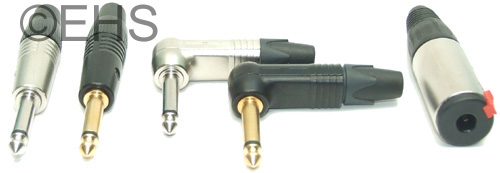 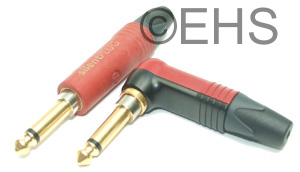 The TS 1/4" connectors we use by Neutrik, Rean, and Hicon:
All Neutrik TS are available with optional colored boot (see Options Info), black is standard. TS 1/4" Speaker options: This is the same TS connector used for line level and instrument cables except that the housing for speaker cables is bigger and heavier duty to support the larger speaker cable.   The TS 1/4" connectors we use are by G&H (except as noted):
Shop our site for: |
||||||||||||||||||||||||||||||||||||||||||||||||||||||||||||||||||||||||||||||||||||||||||||||||
 |
Euro Connector | |||||||||||||||||||||||||||||||||||||||||||||||||||||||||||||||||||||||||||||||||||||||||||||||
|
This is a fairly uncommon connector and is called by several names, such as Phoenix (which is a brand), Euro (there are other connectors called this too), pluggable terminal block, and probably more. These come in many sizes (pin spacing or pitch) and configurations from 2 to 16 pins and have screw terminals to connect the wires. Euro connectors are often used on gear intended for permanent installation. In audio applications, Euro connectors are typically 3-pin connectors, allowing connection of high, low, and ground. They make a good, reliable connection between connectors, although sometimes the wires can be pulled out of the connector if they aren't built well. At EHS, we stock what seems to be the most common sizes, though if you order these on one of our cables, we'll often request the gear make and model from you in order that they are the correct size and pinout. Since gear that uses these often come with them, we can also use your connectors to build the cable if you send them to us, just contact us for details. We can customize anything you might need even if you don't see it on our site. 
Shop our site for: Specialty cables that use these connectors Available on just about any cable by special request |
||||||||||||||||||||||||||||||||||||||||||||||||||||||||||||||||||||||||||||||||||||||||||||||||
 |
1/8" TRS & TS (mini, 3.5mm) | |||||||||||||||||||||||||||||||||||||||||||||||||||||||||||||||||||||||||||||||||||||||||||||||
|
This is another fairly common connector (TRS version) in consumer audio, video lines, and sometimes in pro audio. It is most commonly used as a headphone connector but also as a microphone connector on cameras, synth connections, contact closures, IR controls, and more. It is very similar to the 1/4" connector just smaller in size. It has three main forms; TS, TRS, and TRRS. The TS has two contacts; the Tip and Sleeve; the tip is high and the sleeve is ground/shield. The TRS has three contacts: Tip, Ring, Sleeve; the tip is high or left, the ring is low or right and the sleeve is ground/shield. The TRRS has four contacts and varies by application. Like 1/4" connectors most cables have male connectors, and panels have female connectors. Because most cables only have male connectors, you need an adapter to daisy chain or extend a cable. Because the cable has the same connector on both ends, it doesn't matter which way you run it, although since both ins and outs on a panel use the female connector, you do have to be careful how you hook it up. The 1/8" is a less reliable and more troublesome connector than most. With the exposed contacts, it leaves greater possibility for grime from handling, and they tend to pop on insertion or extraction because you can cross-contact the contacts and short them. The jacks also have a higher failure rate due to wear and dirt. With all that said, they are still great connectors. Here at EHS we offer custom cables with a large selection of connectors. We can customize anything you might need even if you don't see it on our site. TRS 1/8" options:  The TRS connectors we use by Neutrik, Rean, Switchcraft, and Amphenol:
TS 1/8" options: 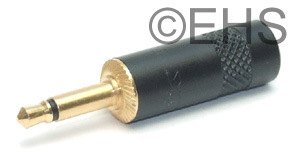 The TS 1/8" we stock are by Rean:
Shop our site for: |
||||||||||||||||||||||||||||||||||||||||||||||||||||||||||||||||||||||||||||||||||||||||||||||||
 |
XLR Mini Connectors | |||||||||||||||||||||||||||||||||||||||||||||||||||||||||||||||||||||||||||||||||||||||||||||||
|
The XLR Mini connector is typically used in microphone connections, often connecting a lapel mic to a body pack. The main configurations used are 3-pin, 4-pin, and 5-Pin. Normally, the female connector found is on a cable end - you rarely see male cable end connectors except on adapters. The XLR Mini has a reasonably reliable connection and is also a latching connector like its big brother. Here at EHS, we stock 3-pin, 4-pin, and 5-pin male and female connectors. The most typical request is for adapter cables. We can customize anything you might need, even if you don't see it on our site. 
|
||||||||||||||||||||||||||||||||||||||||||||||||||||||||||||||||||||||||||||||||||||||||||||||||
 |
Fork Terminals | |||||||||||||||||||||||||||||||||||||||||||||||||||||||||||||||||||||||||||||||||||||||||||||||
|
The Fork Terminal is used on screw terminals or barrier strips. The screw terminal/barrier strips are common on older gear and gear for permanent installation. The fork terminal allows for easy connecting to the screw terminals. These form an excellent and reliable connection, although it does not allow quick, tool-free wiring changes. These are sized by the screw size that they are intended to be screwed to. Here at EHS, we use high-grade connectors in an uninsulated #6 size, and we solder them on for long-term reliability. 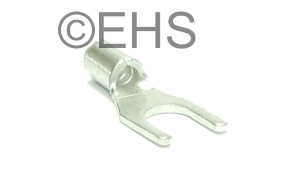 Shop our site for: |
||||||||||||||||||||||||||||||||||||||||||||||||||||||||||||||||||||||||||||||||||||||||||||||||
 |
TT Connectors | |||||||||||||||||||||||||||||||||||||||||||||||||||||||||||||||||||||||||||||||||||||||||||||||
|
The TT (Tini-Telephone) connector is similar to the 1/4" connector but smaller in diameter and shorter in length. It is primarily used on patch systems in studios and live sound. The TT has three contact points: Tip, Ring, Sleeve (TRS); the tip is high or left, the ring is low or right and the sleeve is ground/shield. The TT is an excellent connection that will provide years of trouble-free use when quality products are used. The TT patchbay is far superior to 1/4" patchbays and is often worth the extra cost in the long term. Here at EHS, we offer TT connectors with Mogami 2552 wire in our specialty cables. We can custom wire patchbays but due to the lack of demand, we don't have them on our site. 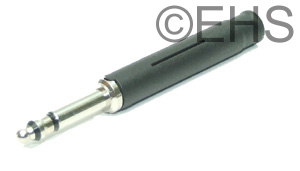 |
||||||||||||||||||||||||||||||||||||||||||||||||||||||||||||||||||||||||||||||||||||||||||||||||
 |
RCA (Phono) | |||||||||||||||||||||||||||||||||||||||||||||||||||||||||||||||||||||||||||||||||||||||||||||||
|
The RCA is probably the most common connector in audio, video, and digital audio. It is used for line-level audio (typically -10dbv consumer level), video (composite or component), and digital SPDIF. It has 2 connecting areas; a center pin for the signal and an outer ring for the ground. Most RCA cables have male connectors, and panels have female connectors. Because most cables only have male connectors, you need an adapter to daisy chain or extend a cable. Because the cable has the same connector on both ends, it doesn't matter which way you run it, although since also both ins and outs on a panel use the female connector you do have to be careful how you hook it up. When quality connectors are used, the RCA is an excellent connection. They lack a latch, but often good connectors will seat tight enough not to need it. They tend to pop when plugged in, so care must be taken to protect gear. Here at EHS we offer our custom cables with these RCA connectors: gold straight connectors in 10 colors, gold right angle, and gold female. We can customize anything you might need, even if you don't see it on our site. 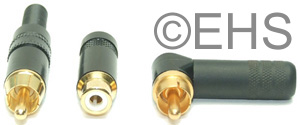 The RCA connectors we use are by Neutrik, Rean and Switchcraft:
|
||||||||||||||||||||||||||||||||||||||||||||||||||||||||||||||||||||||||||||||||||||||||||||||||
| Data/Video | ||||||||||||||||||||||||||||||||||||||||||||||||||||||||||||||||||||||||||||||||||||||||||||||||
 |
RJ-45 | |||||||||||||||||||||||||||||||||||||||||||||||||||||||||||||||||||||||||||||||||||||||||||||||
|
The RJ-45 connector is a very common connector used in network and phone applications. Sometimes referred to as a CAT-5 connector, Ethernet connector, etc. it is an 8P8C connector (8 pole, 8 contact) with a latch. In its basic form, it has relatively low durability, though there are a variety of fancier connectors that have better durability. With the basic version, the biggest problem is that the latch can break off easily if bent backwards. When everything is in good condition, it makes a good solid connection, though as jacks age, they can be problematic. 
|
||||||||||||||||||||||||||||||||||||||||||||||||||||||||||||||||||||||||||||||||||||||||||||||||
 |
EtherCON Neutrik connector | |||||||||||||||||||||||||||||||||||||||||||||||||||||||||||||||||||||||||||||||||||||||||||||||
|
This is a specially designed RJ-45 connector in an XLR-sized housing that contains the RJ-45 in a protective metal shell. It replaces the latch and adds a cable grip and strain relief. These must be matched with the EtherCON panel connector. An EtherCON panel connector will accept a standard cable and the EtherCON, but a standard panel connector will only accept a standard cable. These are very nice additions to a CAT cable, especially when used in the field in a live sound or studio environment. Here at EHS, we offer/stock several versions which use the standard XLR boot, so you have 10 colors options. We can customize anything you might need, even if you don't see it on our site. 
|
||||||||||||||||||||||||||||||||||||||||||||||||||||||||||||||||||||||||||||||||||||||||||||||||
 |
BNC | |||||||||||||||||||||||||||||||||||||||||||||||||||||||||||||||||||||||||||||||||||||||||||||||
|
The BNC is typically used for either clock and video applications as a 75-ohm connection or for antenna applications at 50-ohm. It is similar to the RCA in connection and is often used for the same type of signals, although it has a higher quality connection. It has two connecting areas: a center pin for the signal and an outer ring that spins and works as a latching mechanism for the ground. Most BNC cables have male connectors, and panels have female connectors. Because most cables only have male connectors, you need an adapter to daisy chain or extend a cable. Because the cable has the same connector on both ends, it doesn't matter which way you run it, although since both ins and outs on a panel use the female connector, you do have to be careful how you hook it up. BNC connectors are specific to the wire they fit, so we stock a very large number of them, too many to list all the part numbers here. Here at EHS we offer custom cables with: standard crimp connectors, soldered connectors, and compression connectors in male and female.  Shop our site for: |
||||||||||||||||||||||||||||||||||||||||||||||||||||||||||||||||||||||||||||||||||||||||||||||||
 |
MIDI (5-pin DIN) | |||||||||||||||||||||||||||||||||||||||||||||||||||||||||||||||||||||||||||||||||||||||||||||||
|
The MIDI connector refers to the 5-pin DIN connector with 180-degree pin span. There are nine connector pin arrangements (at least the common ones) ranging from 2 to 8 pins with two 5-pin connectors that have 180-degree and 240-degree pin spans. As stated earlier, it has 5 pins, though for most applications only 3 are used. Most MIDI cables have male connectors, and panels have female connectors. Because most cables only have male connectors, you need an adapter to daisy chain or extend a cable. Because the cable has the same connector on both ends, it doesn't matter which way you run it, although since both ins and outs on a panel use the female connector, you do have to be careful how you hook it up. Here at EHS, we offer custom cables with these straight, right angle, and female connectors.  We also stock 7-pin connectors, often called 7-pin MIDI. They are the same basic concept just with 7 pins.
Shop our site for: |
||||||||||||||||||||||||||||||||||||||||||||||||||||||||||||||||||||||||||||||||||||||||||||||||
| Speaker | ||||||||||||||||||||||||||||||||||||||||||||||||||||||||||||||||||||||||||||||||||||||||||||||||
 |
Banana | |||||||||||||||||||||||||||||||||||||||||||||||||||||||||||||||||||||||||||||||||||||||||||||||
|
The Banana connector is probably both the greatest and simplest speaker connector. It offers a large contact area for high power demand and usually is a fairly solid connection. A banana connector is a one-contact connection, though there are dual banana connectors that contain two contacts. They offer a quick connect/disconnect method, and if you are using a dual banana, they are moderately safe from shorting out. The dual banana is typically the safest pick to protect equipment from shorts, though some amps and speakers have a wider spacing on the jacks so that you must use split banana connectors. The dual connectors have a 3/4" (.75") spacing center-to-center. Here at EHS, we offer our custom cables with a large selection of banana connectors. We can customize anything you might need, even if you don't see it on our site. 
Shop our site for: |
||||||||||||||||||||||||||||||||||||||||||||||||||||||||||||||||||||||||||||||||||||||||||||||||
 |
Spade lugs | |||||||||||||||||||||||||||||||||||||||||||||||||||||||||||||||||||||||||||||||||||||||||||||||
|
The Spade lug, or fork, is for special applications typically involving high current or very large wire. Often used when a banana connector is not available, it offers similar contact benefits to bananas. While it is slower to connect and disconnect, it is also almost impossible to accidentally disconnect a properly terminated connection. Here at EHS, we stock and offer our custom cables with top quality, gold, heavy-duty lugs. There are many styles of screw terminals, and we can customize anything you might need, even if you don't see it on our site 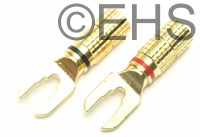
Shop our site for: |
||||||||||||||||||||||||||||||||||||||||||||||||||||||||||||||||||||||||||||||||||||||||||||||||
 |
Speakon | |||||||||||||||||||||||||||||||||||||||||||||||||||||||||||||||||||||||||||||||||||||||||||||||
|
The Speakon is one of the most convenient and safest speaker connectors around. It comes in 2, 4, and 8 poles (contacts), has a latch to prevent accidental disconnect, and has a cable clamp to help prevent the cable from being pulled out of the connector. Its contacts are completely enclosed, and the connector is keyed to be mated only one way, making it almost impossible to cause a short and damage an amp even when hot-swapping. The majority of gear uses the 4-pole connector. Most Speakon cables have female connectors, and panels have male connectors. Because most cables only have female connectors, you need an adapter to daisy chain or extend a cable. Because the cable has the same connector on both ends, it doesn't matter which way you run it. Here at EHS, we stock the most commonly needed Speakon connectors. We can customize anything you might need, even if you don't see it on our site.  The Speakon connectors we use are by Neutrik:
Shop our site for: |
||||||||||||||||||||||||||||||||||||||||||||||||||||||||||||||||||||||||||||||||||||||||||||||||
| Mass/Multi-Channel | ||||||||||||||||||||||||||||||||||||||||||||||||||||||||||||||||||||||||||||||||||||||||||||||||
 |
EP/AP | |||||||||||||||||||||||||||||||||||||||||||||||||||||||||||||||||||||||||||||||||||||||||||||||
|
The EP/AP connector is a pin-style speaker connector, sort of like a large, XLR-looking connector. It is not a very common connector, often used on older, high-end cabinets and touring cabinets. Pinouts and configurations vary by the manufacturer, so if you need a cable, we'll often need to confirm what is being connected. EP and AP are compatible connectors EP is a heavy-duty metal connector, and AP is a plastic housing connector. At EHS, we keep a very small stock of the most commonly needed connectors. If it is time-critical, please check with us before ordering. We can customize anything you might need, even if you don't see it on our site.  We use all Amphenol connectors unless requested otherwise:
Shop our site for: |
||||||||||||||||||||||||||||||||||||||||||||||||||||||||||||||||||||||||||||||||||||||||||||||||
 |
D-Sub | |||||||||||||||||||||||||||||||||||||||||||||||||||||||||||||||||||||||||||||||||||||||||||||||
|
The D-Sub is a very common connector. For audio, we typically use the 25 pin connector, referred to as a DB-25, D-subminiature, and D-sub 25pin. You might also see them with 9 and 15 pins on some less common layouts. The standard 25-pin in audio is used for an 8-channel balanced analog, 8-line AES/EBU, and TDIF. Other signals are sometimes used but are uncommon. Analog connection typically has one standard pinout, sometimes called the "Tascam pinout." It is used for both in or out, and sometimes even in and out on the same connector. For use as a digital connection with AES/EBU, using a D-Sub gets much more complicated. There are several major pinouts used by major manufacturers. Often it is used as four lines in and four lines out, but then it can be complicated by things like eight-channel A/D converters that have four lines out. TDIF seems to be a dying format, but it has a standard pinout that, as far as we can tell, everyone uses. Here at EHS, we offer our custom cables with a large selection of D-sub options all from the Norcomp product line. We have the most common options on our site and are working on listing more, although there are so many possible ways to build a D-sub snake that we will never be able to cover them all. We can customize anything you might need, even if you don't see it on our site. 
Shop our site for: |
||||||||||||||||||||||||||||||||||||||||||||||||||||||||||||||||||||||||||||||||||||||||||||||||
 |
DL | |||||||||||||||||||||||||||||||||||||||||||||||||||||||||||||||||||||||||||||||||||||||||||||||
|
The DL is a ZIF (zero insertion force) connector. These are slowly becoming a more uncommon connector. It comes in a variety of connector sizes, 96-pin being one of the more common. These are often found on SSL (Solid State Logic) consoles and some analog cue systems and can be built custom for machine rooms in studios. It is typically a black connector with an actuating handle that turns about 90 degrees to connect the pins and latch down. Here at EHS, we stock a small stash of these for our studio clients; we don't currently have any offered on our site, but if you need something, please contact us. 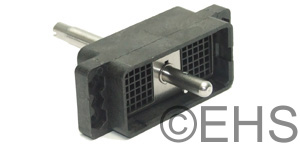 Male 96 pin DL (unpinned) Shop our site for: |
||||||||||||||||||||||||||||||||||||||||||||||||||||||||||||||||||||||||||||||||||||||||||||||||
 |
ELCO | |||||||||||||||||||||||||||||||||||||||||||||||||||||||||||||||||||||||||||||||||||||||||||||||
|
The ELCO (aka EDAC) connector comes in six sizes of 3, 20, 38, 56, 90, and 120 so that it can support up to 40 channels of balanced analog signal. These are more common than the DL connector, but their use is dwindling, too. ELCO's are often found on (perhaps older) Neve, Amek, Soundcraft, and other consoles and are also used on some gear and in machine rooms for studios. It is typically a gray or green connector with a gray metal hood. They are defined as either having a "screw" or a "nut." If it has a screw, it will have a knob or handle in the center back of the connector hood that is used to mate and seat the connectors together. Because the pins fit so tightly together, often a fully or nearly fully loaded connector will require the force of the screw to seat the connectors together completely. A properly constructed ELCO in good condition forms an excellent connection that is very reliable. Here at EHS, we offer our custom snakes with an optional ELCO disconnect, which is great to disconnect a mixer from the stage snake for quick setup and teardown. We can customize an ELCO for anything, but because there are so many options, it is best to contact us for information. 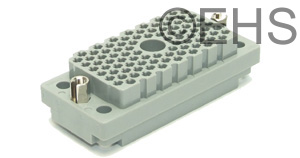 Female ELCO with Nut (unpinned)
Shop our site for: |
||||||||||||||||||||||||||||||||||||||||||||||||||||||||||||||||||||||||||||||||||||||||||||||||
| Other Multi-pin | ||||||||||||||||||||||||||||||||||||||||||||||||||||||||||||||||||||||||||||||||||||||||||||||||
|
There is an endless variety of other multi-pin connectors out there, but we have listed the ones we most commonly use. If you have any interest in a different type of connector, please contact us to discuss options. Shop our site for: |
||||||||||||||||||||||||||||||||||||||||||||||||||||||||||||||||||||||||||||||||||||||||||||||||
Copyright © 2025 Event Horizon & Services





